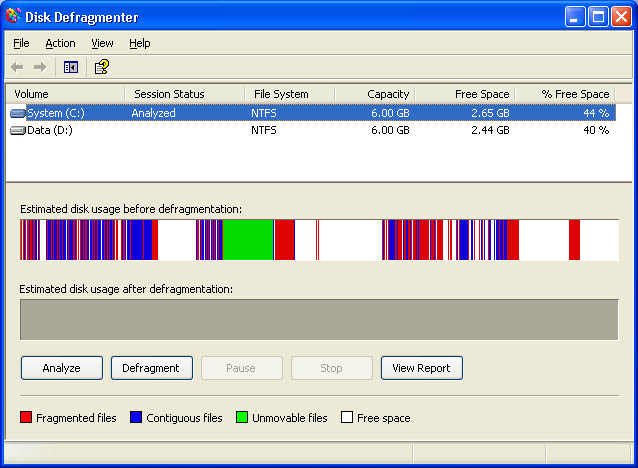

- #How to clean up and defrag my computer how to#
- #How to clean up and defrag my computer windows 10#
- #How to clean up and defrag my computer password#
- #How to clean up and defrag my computer free#
- #How to clean up and defrag my computer windows#
That way, you won’t have to remember to do it manually in the future.įeel free to close the Optimize Drives window and use your computer as normal-and don’t be surprised if you feel a little extra spring in your computer’s step. If you’d like, you can schedule regular defragmentation sessions in the Optimize Drives window by clicking the “Turn On” button in the “Scheduled Optimization” section. When the process is complete, the time in the Last Run column will update, and the Current Status will read something similar to “OK (0% fragmented).”Ĭongratulations, your drive has been successfully defragmented. You will see a percentage complete progress indicator in the Current Status column. If the disk needs optimizing and defragmenting, the process will begin.
#How to clean up and defrag my computer windows#
On SSDs, it runs a TRIM command, which can potentially speed up the operation of your drive, but it isn’t really necessary as Windows does this in the background with modern drives. On a hard disk drive, this runs a defragmentation routine. Select the drive you’d like to defragment in the list, then click “Optimize.”
#How to clean up and defrag my computer windows 10#
The fact that Windows 10 lacks a big Tune-Up My PC button that starts all the wheels turning is a knock against it. For example, a computer program must access various files on the hard. Your PC will boot faster and run smoother.Unfortunately, Windows 10 lacks a singular tune-up tool theyre scattered across the operating system, lacking a centralized location. Defragmenting a hard drive is a common maintenance process that rearranges data in a contiguous fashion ultimately increasing performance. RELATED: What's the Difference Between FAT32, exFAT, and NTFS? Defragmenting the computer gathers and organizes the files, which usually improves retrieval time and the computers overall performance. Drives formatted as exFAT will not appear in the list. When the scanning is complete, check for all the additional files that you can delete, and click OK. This will make the tool scan a second time and give you some more options. Once the tool finishes scanning, click on Clean up system files. If one of your drives doesn’t show up, it may be because Windows 10 can only optimize drives formatted in the NTFS filesystem. Once the tool opens up, select the C: drive (default) and click OK. The Optimize Drives window will appear, and it will list all of the drives in your system that are eligible for optimization and defragmentation.
#How to clean up and defrag my computer how to#
RELATED: Do I Really Need to Defrag My PC? How to Defragment Your Hard Disk on Windows 10įirst, press the Windows key or click the search box on your taskbar and type “defragment.” Click the “Defragment and Optimize Your Drives” shortcut in the Start menu. You might also need to defragment external hard disk drives connected via USB, as they may not be plugged in when Windows runs its automatic defragmentation. Still, it doesn’t hurt to keep your drives operating in the most efficient way possible. Windows automatically defragments mechanical drives, and defragmentation isn’t necessary with solid-state drives. However, with modern computers, defragmentation isn’t the necessity it once was. Defragmenting moves all of those blocks so they are located close together in physical space, which potentially speeds up read times when accessing data on the disk.

Please post in case you have any further issues, we are happy to help you further.Over time, the data blocks (fragments) that make up files can become scattered in multiple locations around the surface of the hard disk. SeeĬheck a drive for errors for more information. Try to repair the disk first, then return to Disk Defragmenter to try again. If a disk that you're expecting to see underĬurrent status is not showing up there, it might be because it contains an error. If the disk is already in exclusive use by another program or is formatted using a file system other than NTFS file system, FAT, or FAT32, it can't be defragmented. You can still use your computer during the defragmentation process.
#How to clean up and defrag my computer password#
If you're prompted for an administrator password or confirmation, type the passwordĭisk Defragmenter might take from several minutes to a few hours to finish, depending on the size and degree of fragmentation of your hard disk. If the number is above 10%, you should defragment the disk.Ĭlick Defragment disk. Once Windows is finished analyzing the disk, you can check the percentage of fragmentation on the disk in the To determine if the disk needs to be defragmented or not, clickįor an administrator password or confirmation, type the password or provide confirmation. Under Current status, select the disk you want to defragment. In the search box, type Disk Defragmenter, and then, in the list of results, click


 0 kommentar(er)
0 kommentar(er)
